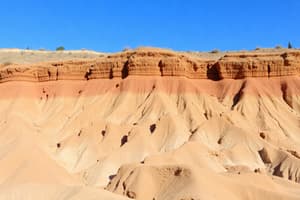Podcast
Questions and Answers
What is weathering?
What is weathering?
- The movement of soil particles by wind and water
- The breakdown of larger rock fragments into smaller particles (correct)
- The accumulation of debris and smaller particles in a new place
- The formation of sediments through mechanical, chemical, and biological processes
What is erosion?
What is erosion?
- The movement of the mole leading to the breakdown of soil particles
- The transportation of smaller particles to a new site by water, wind, or ice (correct)
- The breakdown of larger rock fragments into smaller particles
- The accumulation of debris and smaller particles in a new place
What is deposition?
What is deposition?
- The formation of sediments through mechanical, chemical, and biological processes
- The breakdown of larger rock fragments into smaller particles
- The movement of soil particles by wind and water
- The accumulation of debris and smaller particles in a new place (correct)
Which process leads to the formation of sediments?
Which process leads to the formation of sediments?
What are the common transporting mediums for erosion?
What are the common transporting mediums for erosion?
What depositional landform is formed when a river overflows and deposits materials adjacent to the river?
What depositional landform is formed when a river overflows and deposits materials adjacent to the river?
Which depositional landform is created by the deposition and accumulation of sands carried by strong winds in the desert region?
Which depositional landform is created by the deposition and accumulation of sands carried by strong winds in the desert region?
What type of moraine is formed when a thick mass of glacier moves over a region and leaves unconsolidated, loose accumulated materials as it recedes?
What type of moraine is formed when a thick mass of glacier moves over a region and leaves unconsolidated, loose accumulated materials as it recedes?
What depositional landform is known as the mouth of a river, where the river deposits all its sediments before flowing into the seas and oceans?
What depositional landform is known as the mouth of a river, where the river deposits all its sediments before flowing into the seas and oceans?
What depositional landform is formed when moving glaciers carry sand and gravel size particles to a comparatively low-lying area where the glaciers melt, leaving only the accumulated materials?
What depositional landform is formed when moving glaciers carry sand and gravel size particles to a comparatively low-lying area where the glaciers melt, leaving only the accumulated materials?
Which process involves slowly breaking down rocks through plant and animal activities?
Which process involves slowly breaking down rocks through plant and animal activities?
What landforms are created by water erosion?
What landforms are created by water erosion?
Which agent of erosion forms sea cliffs, sea arches, and sea stacks along coastal areas?
Which agent of erosion forms sea cliffs, sea arches, and sea stacks along coastal areas?
What determines the rate of erosion?
What determines the rate of erosion?
Which process involves the transportation of sediments to new locations?
Which process involves the transportation of sediments to new locations?
Flashcards are hidden until you start studying
Study Notes
Weathering and Erosion: Key Processes and Landforms
- Physical weathering processes include freeze and thaw method, exfoliation, and abrasion.
- Chemical weathering processes involve hydrolysis, oxidation, and acid rain weathering.
- Biological weathering is caused by plant and animal activities, slowly breaking down rocks.
- Weathering and erosion constantly shape the Earth's surface, forming a variety of landforms.
- Fluvial erosion creates river valleys, oxbow lakes, waterfalls, sinkholes, and caves.
- Wind erosion forms landforms such as inselbergs, mushroom rocks, and pediplains.
- Water erosion creates valleys, canyons, waterfalls, ox-bow lakes, and ripple marks.
- Waves create sea cliffs, sea arches, and sea stacks along coastal areas.
- Erosion, caused by wind, water, and glaciers, transports sediments to new locations.
- The rate of erosion depends on the environment, availability of wind, water, and climate.
- Erosion changes the landscape over thousands to millions of years, making it a slow process.
- Wind, water, glaciers, waves, and gravity are the main agents of erosion, each affecting rock bodies differently.
Studying That Suits You
Use AI to generate personalized quizzes and flashcards to suit your learning preferences.




